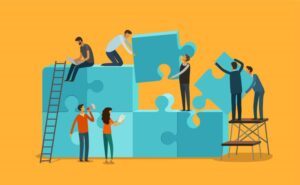In this month’s legal column from Eversheds Sutherland, Catherine Henney, speaks to Mental Health Strategist and Consultant, Amy McKeown, about the impact of the pandemic on workers’ mental health and ISO45003, the first international standard on managing psychological health and safety at work.
 The impact of increased screen time on child and adolescent mental health has been studied and written about for some time now. However, recent years have seen a dramatic increase in adult screen time, with the pandemic forcing millions of workers into working from home and spending many more hours a day on video meetings and calls than they otherwise would have in their ‘normal’ working day. It’s no wonder that these employees are also reporting (and showing) more signs of fatigue, stress and anxiety than ever before.
The impact of increased screen time on child and adolescent mental health has been studied and written about for some time now. However, recent years have seen a dramatic increase in adult screen time, with the pandemic forcing millions of workers into working from home and spending many more hours a day on video meetings and calls than they otherwise would have in their ‘normal’ working day. It’s no wonder that these employees are also reporting (and showing) more signs of fatigue, stress and anxiety than ever before.
Working from home – with the lack of distinction between the home and the work-place – has led to a culture of working hours drifting longer across the day; people feel that they never switching off, and taking fewer breaks from the screen. A day of back-to-back Zoom or Teams calls can leave us feeling mentally exhausted and – personally speaking – with a head full of fuzz and sore, dry eyes. It’s something I like to call the “Zoombie” effect, and it appears to be an increasingly common psychological side effect of increased home-working, and one that employers as well as employees as struggling to grapple with.
How can employers monitor this “Zoombie” effect – and psychological wellbeing in general – to ensure working from home does not negatively impact mental health and well-being? It’s something I put to my colleague, Workplace Mental Health Strategist and Consultant Amy McKeown, to gauge her insights into this important topic, and what she has seen organisations doing well, or badly, in this space.
Catherine Henny (CH): Do you think my experience is typical of the kind of clients you’ve worked with post-pandemic? I hope I’m not alone in feeling a lot more exhausted at the end of a day working from home than I thought possible!
Amy Mckeown (AM): Your experience is something that I have heard a lot of clients discuss recently. Due to Covid we are in the biggest shake up of working conditions and practises that we have ever seen or experienced. Every organisation is grappling with how to get this right. No one has yet cracked hybrid or flexible working and how to do this well or in a way that doesn’t lead to the symptoms you described above. If we manage this transition in working practises well then this could be revolutionary for how we work and open the workplace to people who have traditionally been marginalised (people with caring responsibilities, mothers, people with disabilities or health and mental health conditions). So I really hope we do figure how to work in a more hybrid model. What has happened so far though is that we are working on Zoom in the same way we worked in the office and spending most of the day on transactional back to back video calls. We haven’t redesigned roles or jobs to reflect these big changes. Much has, of course, been written about flexible working and the transition back to the office and allowing for hybrid working. For many office-based organisations, this may not be ground-breaking; certainly, many law firms have been promoting flexible working pre-pandemic. However, for workers in non-office-based roles, the psychological impact of their post-pandemic return to work may be vastly different – but still must be managed by their employer. The duty under Section 2 of the Health and Safety at Work etc Act 1974 is the same.
CH: Do you think there has been a difference across industries as to how employers have sought to manage psychological wellbeing, and do you have any examples of where this has been done particularly well – or badly (without naming names of course!)?
AM: I have not seen a big issue in different industries per se, though I am finding it interesting seeing how different industries manage this transition. Banks and city firms were often the first to insist their people were back in the office first for example. Where I have seen this work well has been where organisations, rather than rushing to write policies or insist on certain hybrid working rules, have sat back and watched how employees are working and what would suit them best; worked with them to understand what ways of working help them be more productive, creative and support a balanced life style; and then worked from there to create the right structure. Sadly, this happens less than a dictatorial policy being imposed. I will also make the point that working in a hybrid or more flexible way requires different skills. Meeting structure and working practices need to be altered. Management and communication styles need to be thought through and adapted. Especially when we are talking about psychological wellbeing. It is much easier to become and remain isolated when remote working. Managers need to reach out more and manage in a different way. Organisations that understand that this is a completely new way of working and train their people in the skills for this are the ones that are doing best.
ISO 45003 also acts as a standalone guide, which organisations can use and implement without having formally implemented ISO 45001
June 2023 marks two years since the introduction of the first international standard on managing psychological health and safety at work. The global standard is designed to complement ISO 45001, the global management standard for occupational health and safety management, so that organisations can bring the recommended standards for psychological wellbeing within their existing H&S management systems. However, ISO 45003 also acts as a standalone guide, which organisations can use and implement without having formally implemented ISO 45001.
The standard sets out ten clauses, and aims to provide practical, proactive steps that organisations can introduce to ensure that employees feel supported, and managers empowered, to address and manage their psychological as well as physical health. This includes guidance on how to identify triggers – which may be within or outside of the workplace – and what should be done to tackle this in the most appropriate way. It also looks at how to prevent psychosocial risks arising in the workplace. Organisations seeking certification under ISO 45003 are audited against the clauses to check whether the system they implement conforms with all aspects of the international standard. The first UK organisation to achieve certification was EMCOR, in October 2021. However it is difficult to assess the general uptake of the standard, with no published list of certified companies currently available.
CH: In your experience, has ISO 45003 had a positive impact upon organisational culture towards psychological safety in the workplace, and do you think its success can be measured even in the absence of official certification?
 AM: Very much so. ISO 45003 came out during the pandemic (although creation of it was happening before). It was created out of a response to a need to do something to reduce the high levels of psychological risk and builds on an organisational risk management approach. The standard focuses and draws together the prevention activities that were needed all along in other stress and mental health approaches. Initial sales figures show that ISO 45003 is doing well and being purchased by a range of organisations.
AM: Very much so. ISO 45003 came out during the pandemic (although creation of it was happening before). It was created out of a response to a need to do something to reduce the high levels of psychological risk and builds on an organisational risk management approach. The standard focuses and draws together the prevention activities that were needed all along in other stress and mental health approaches. Initial sales figures show that ISO 45003 is doing well and being purchased by a range of organisations.
With standards of this type there is, of course, a lag between organisations buying the standard and reaching certification stage. We know that it is popular, people are using it and that over time this will set a benchmark and baseline for psychosocial health. Which was its aim.
CH: If you had to pick out one particularly strong thread from ISO 45003, which you think all organisations should adopt as a non-negotiable, what would it be?
AM: It would be that it is focused on the prevention of risk factors for psychological illness and offers practical steps and solutions to achieve this. Other past approaches have centred around the risk assessment only, and this has left employers unsure of what to do about the risks they have discovered. ISO 45003 is considered a ‘management system’ approach which, as well as identifying risk factors, shows you what you need to do to resolve them.
One of the common misconceptions is that psychological wellbeing, in the context of workplace safety, relates solely to stress, anxiety or depression. Often, in my experience, there is less understanding around the term “psychosocial risk”, and what this means – as it is the duty to prevent exposure to psychosocial risks which employers should be seeking to identify and address, not a duty to ensure wellbeing. We often include other examples in training or advice to clients, such as where someone may have an underlying health condition (whether physical or mental) such that certain workplace situations trigger a psychological reaction in them – for example particular noises, or lighting, or temperature fluctuations.
Women going through the menopause are another example of where, previously, they may not have experienced any psychosocial issues in the workplace, but where their symptoms are such that they are finding it particularly tough to cope at work. What is increasingly clear, though, is that managing psychological wellbeing in the workplace is intrinsically linked to an organisation’s approach to equity, diversity and inclusion in general.
CH: What would you say to employers about what they should think of (or look for) when considering examples of psychosocial risks?
AM: I think employers need to think about the need to redesign and reshape job roles and demand to manage the psychological risks considered. This is often the missing piece of the jigsaw and what we are seeing in our approach to hybrid and flexible working. It is one thing undertaking a risk assessment, but work needs to be done after this to change how people are working to improve things. Changing job demands and design can be a big undertaking but will pay dividends. You must be prepared to do this work.
Giving people control over themselves and their working lives has been shown to reduce risk dramatically
What we did see over Covid is the impact that having some control over your job and working life has. If you have control over how and when you work, and what your demands are and how they are managed, this has a disproportionate impact on psychological risk. Giving people control over themselves and their working lives has been shown to reduce risk dramatically.
At Eversheds Sutherland, we spend a considerable amount of our time in the EHS team helping clients carry out deep-dive reviews into their health and safety management systems, including their governance and leadership structures and health and safety culture. The importance of leaders being visible and encouraging challenge and “speaking up” in all aspects of health and safety is key to promoting good safety compliance; but often there is still a stigma attached to speaking up when it comes to psychological wellbeing and struggling with our mental health.
CH: Do we need more leaders speaking out about mental health and raising awareness within their own workplaces – or do you think many still see admitting to this as a weakness?
AM: It is a question I get asked a lot, as senior workers and boards are often the hardest to convince of the need to do work around mental health. Younger employees ‘get it’ and are insisting upon mental health being part of their employee value proposition. Often the more senior employees are the most sceptical. I think leaders buying in and championing this work is the most effective way of making organisational change.
For employees to believe that an organisation really cares about mental health and wellbeing and not just paying lip service, they need to see senior leaders talking about it, role modelling good mental health behaviours and rewarding the right behaviours in the performance management system.
CH: Finally, what would you say to organisations or leaders who are looking to review their approach to wellbeing in the workplace, post-pandemic? What should they start by doing?
AM: They should start by being clear about what they are trying to achieve and why. My career has been creating and implementing comprehensive, long-term, sustainable health and mental health strategies across organisations of all sizes. The most common problem I see is organisations rushing into do this work without a clear idea of what they are trying to achieve, and what health, wellbeing or mental health means to them. Most mental health strategies I see are ill-thought-through mental illness strategies, based in HR, D&I or H&S. They aren’t a comprehensive, multi-stakeholder organisational approach and often leave an organisation vulnerable. This needs thinking about as part of a wider long-term organisational culture change. It needs structure, strategy, senior leadership support, resource, and expertise. Someone who knows what they are doing and why, not just someone in the organisation with a ‘passion’ or interest in mental health or wellbeing leading it.
Interestingly, this is a sentiment we very much endorse when advising our clients in relation to their wider approach to H&S too – that it needs to be led from the top, with a clear organisational purpose, and that such systems need to be able to respond to the needs, concerns and views of the workforce. Mental health strategies are no different – and as you say, this is why ISO 45003 has been built in such a way that it can (and should) be integrated within existing H&S management systems.
Equally, the best approaches we have seen to hybrid working and accounting for the ongoing wellbeing of at-home or remote working, have been those which have trialled, monitored and responded to the changing way of working; to see what gets the best out of both the people and the business, by trying to achieve a healthy balance.
I hope that, in time, we will continue to see a better shift towards hybrid working and employers truly understanding the psychosocial risks associated with it – simply by knowing more about it and, more importantly, learning from their workers as to how they are finding it. I am also hopeful that there will be less Zoom-bie fatigue, as hybrid or blended working becomes the norm: my personal way of managing this is to use my office days to structure more face to face meetings, and thereby try to reduce my video calls on days when at home. Just a small thing, but one that works for me.

Catherine Henney is a Legal Director at Eversheds Sutherland, and heads up the Health & Safety team in Manchester. She has a Masters in Health & Safety and Environmental Law, and regularly advises corporate clients in relation to health and safety compliance, as well as crisis and risk management. She frequently works with leadership teams to look at their safety strategies and culture, and represents clients across all sectors when they are investigated and/or prosecuted by HSE and other regulatory bodies.

Amy McKeown is an award-winning health, mental health and wellbeing consultant. She coaches organisations of all sizes to build strategies with are both innovative and measurable, whilst providing unique expertise in implementing said strategies. Amy is also a respected thought-leader within her field, sharing her advice regularly on LinkedIn and at speaker events such as Mad World.
Cover image credit: LinkedIn Sales Solutions
What makes us susceptible to burnout?
In this episode of the Safety & Health Podcast, ‘Burnout, stress and being human’, Heather Beach is joined by Stacy Thomson to discuss burnout, perfectionism and how to deal with burnout as an individual, as management and as an organisation.
We provide an insight on how to tackle burnout and why mental health is such a taboo subject, particularly in the workplace.

 The impact of increased screen time on child and adolescent mental health has been studied and written about for some time now. However, recent years have seen a dramatic increase in adult screen time, with the pandemic forcing millions of workers into working from home and spending many more hours a day on video meetings and calls than they otherwise would have in their ‘normal’ working day. It’s no wonder that these employees are also reporting (and showing) more signs of fatigue, stress and anxiety than ever before.
The impact of increased screen time on child and adolescent mental health has been studied and written about for some time now. However, recent years have seen a dramatic increase in adult screen time, with the pandemic forcing millions of workers into working from home and spending many more hours a day on video meetings and calls than they otherwise would have in their ‘normal’ working day. It’s no wonder that these employees are also reporting (and showing) more signs of fatigue, stress and anxiety than ever before.  AM: Very much so. ISO 45003 came out during the pandemic (although creation of it was happening before). It was created out of a response to a need to do something to reduce the high levels of psychological risk and builds on an organisational risk management approach. The standard focuses and draws together the prevention activities that were needed all along in other stress and mental health approaches. Initial sales figures show that ISO 45003 is doing well and being purchased by a range of organisations.
AM: Very much so. ISO 45003 came out during the pandemic (although creation of it was happening before). It was created out of a response to a need to do something to reduce the high levels of psychological risk and builds on an organisational risk management approach. The standard focuses and draws together the prevention activities that were needed all along in other stress and mental health approaches. Initial sales figures show that ISO 45003 is doing well and being purchased by a range of organisations. 

